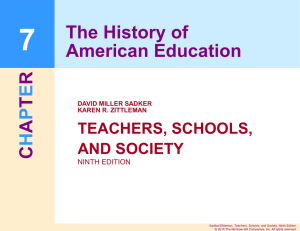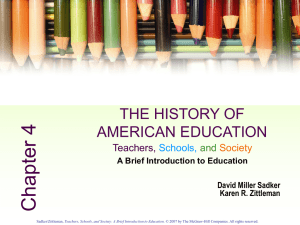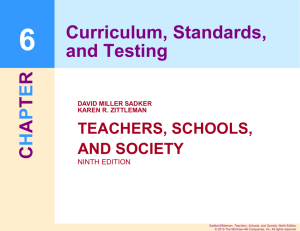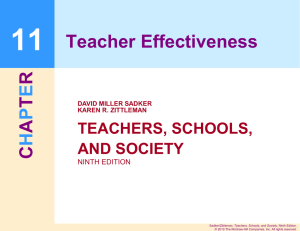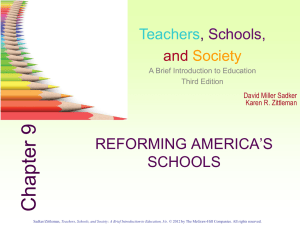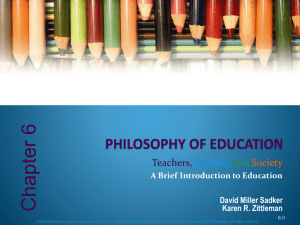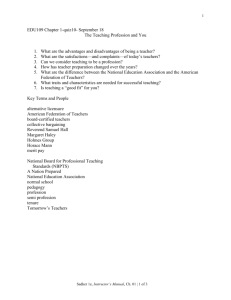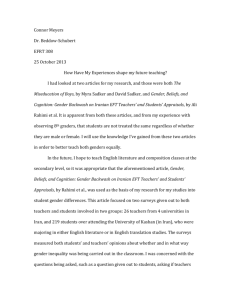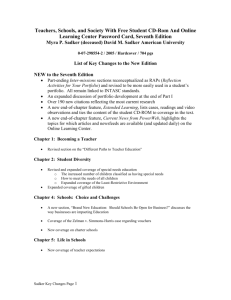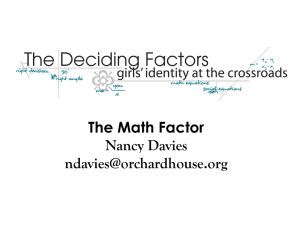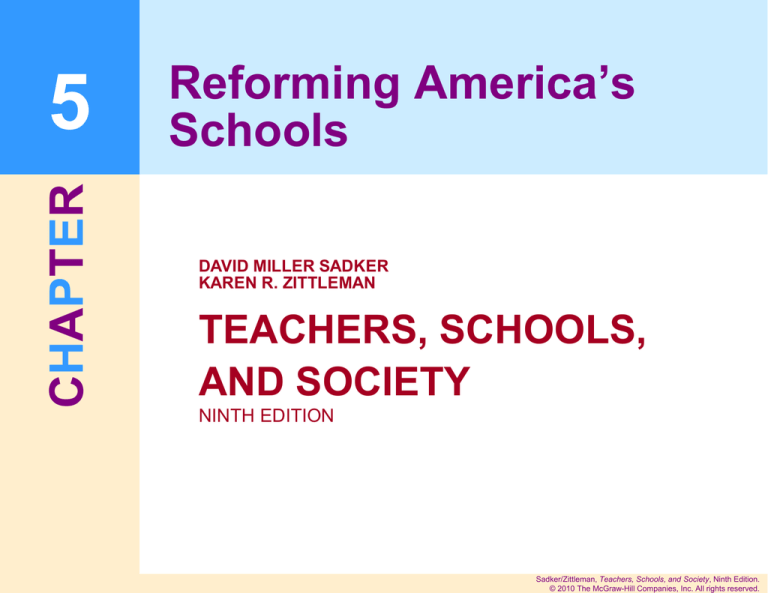
CHAPTER
5
Reforming America’s
Schools
DAVID MILLER SADKER
KAREN R. ZITTLEMAN
TEACHERS, SCHOOLS,
AND SOCIETY
NINTH EDITION
Sadker/Zittleman, Teachers, Schools, and Society, Ninth Edition.
© 2010 The McGraw-Hill Companies, Inc. All rights reserved.
5.1
THE PURPOSE OF SCHOOL
Student Generated Responses
Examples
Purpose 1:
To transmit society’s knowledge
and values
Purpose 2:
To reconstruct
society
Which purpose most characterizes the schools you attended?
Sadker/Zittleman, Teachers, Schools, and Society, Ninth Edition.
© 2010 The McGraw-Hill Companies, Inc. All rights reserved.
5.2
Figure 5.1
GOALS OF SCHOOLS
Sadker/Zittleman, Teachers, Schools, and Society, Ninth Edition.
© 2010 The McGraw-Hill Companies, Inc. All rights reserved.
5.3
HISTORY OF REFORM
Committee of Ten (1892)
Cardinal Principles of Secondary Education (1918)
A Nation at Risk (1983)
Sadker/Zittleman, Teachers, Schools, and Society, Ninth Edition.
© 2010 The McGraw-Hill Companies, Inc. All rights reserved.
5.4
PUBLIC ATTITUDES: REFORMING OR
REPLACING PUBLIC SCHOOLS
Source: The 2007 Phi Delta Kappa/Gallup Poll of the Public’s Attitudes Toward the Public Schools.
Figure 5.2
Sadker/Zittleman, Teachers, Schools, and Society, Ninth Edition.
© 2010 The McGraw-Hill Companies, Inc. All rights reserved.
5.5
CHARTER SCHOOLS
Most charter schools:
• Allow for the creation of a new or the conversion of an
existing public school
• Prohibit admission tests
• Are nonsectarian
• Require a demonstrable improvement in performance
• Can be closed if expectations are not met
• Do not need to conform to most state rules and regulations
• Receive funding based on the number of students enrolled
Sadker/Zittleman, Teachers, Schools, and Society, Ninth Edition.
© 2010 The McGraw-Hill Companies, Inc. All rights reserved.
5.6
PRINCIPLES OF KIPP CHARTER SCHOOLS
(Knowledge is Power Program)
1. More Time. KIPP schools have longer school days and a longer
school year.
2. High Expectations. Students, parents, teachers, and staff work to
create a culture of achievement and support.
3. Choice & Commitment. Everyone in a KIPP school chooses to be
there, and to put in time and effort required to succeed.
4. Power to Lead. The principals of KIPP schools have control over
their school budget and personnel are held accountable for
learning. There is no central bureaucracy.
5. Focus on Results. Students are expected to achieve a level of
academic performance that will enable them to graduate and go
on to the nation’s best high schools and colleges.
Sadker/Zittleman, Teachers, Schools, and Society, Ninth Edition.
© 2010 The McGraw-Hill Companies, Inc. All rights reserved.
5.7
PUBLIC FUNDS, PRIVATE SCHOOLS,
AND VOUCHERS
The Lemon test (1973)
1. Secular purpose,
2. Must not primarily advance or prohibit religion, and
3. Must not result in excessive government entanglement with
religion.
But in Zelman v. Simmons-Harris (2002), a narrow 5-4 Supreme
Court ruling allowed publicly funded vouchers to send children to
Cleveland’s private religious schools.
Chief Justice William Rehnquist: Vouchers permit a “genuine choice
among options public and private, secular and religious.”
Justice John Paul Stevens: “Whenever we remove a brick from the
wall that was designed to separate religion and government, we
increase the risk of religious strife and weaken the foundation of
our democracy.”
Sadker/Zittleman, Teachers, Schools, and Society, Ninth Edition.
© 2010 The McGraw-Hill Companies, Inc. All rights reserved.
5.8
PRIVATE SCHOOLS AT PUBLIC EXPENSE
Source: The 2008 Phi Delta Kappa/Gallup Poll of the Public’s Attitudes toward the Public Schools.
Figure 5.3
Sadker/Zittleman, Teachers, Schools, and Society, Ninth Edition.
© 2010 The McGraw-Hill Companies, Inc. All rights reserved.
5.9
WHO ARE HOME SCHOOLERS?
Source: National Center for Education Statistics, “Homeschooled Students,” The Condition of Education, Indicator 6 (May, 2009).
Figure 5.4
Sadker/Zittleman, Teachers, Schools, and Society, Ninth Edition.
© 2010 The McGraw-Hill Companies, Inc. All rights reserved.
5.10 FACTORS SUPPORTING EFFECTIVE SCHOOLS
• Strong leadership
• Clear school mission
• Safe and orderly climate
• Monitor student progress
• High expectations
Sadker/Zittleman, Teachers, Schools, and Society, Ninth Edition.
© 2010 The McGraw-Hill Companies, Inc. All rights reserved.
5.11 SCHOOL RELATED VIOLENCE
Source: National Center for Education Statistics, Indicators of School Crime and Safety, 2007 (Issued April 21, 2009).
Figure 5.5
Sadker/Zittleman, Teachers, Schools, and Society, Ninth Edition.
© 2010 The McGraw-Hill Companies, Inc. All rights reserved.
5.12 FACTORS RESPONSIBLE FOR SCHOOL SAFETY
1. Staff works together
2. Shared authority and decision making
3. Sense of ownership by students
4. Rules/procedures encourage self-discipline
5. Curriculum is interesting and challenging
6. Staff assists students with personal problems
7. Strong school-home cooperation
8. School structure (physical/organizational) supports these
factors
9. Other factors?
Sadker/Zittleman, Teachers, Schools, and Society, Ninth Edition.
© 2010 The McGraw-Hill Companies, Inc. All rights reserved.
STUDENT OBSERVATIONS OF EFFECTIVE
5.13
SCHOOL PRACTICES
Effective
School Practices
Ineffective
School Practices
Principal
Climate
Safety
Student Progress
Teacher Expectations
Sadker/Zittleman, Teachers, Schools, and Society, Ninth Edition.
© 2010 The McGraw-Hill Companies, Inc. All rights reserved.
5.14 BEYOND THE FIVE FACTORS
• Start early
• Focus on reading and math
• Make schools smaller
• Make classes smaller
• Increase learning time
• Involve parents
• Train teachers
• Trust
Sadker/Zittleman, Teachers, Schools, and Society, Ninth Edition.
© 2010 The McGraw-Hill Companies, Inc. All rights reserved.

